|
Level
Layout, Disneyland Style
By
Stephen Clarke-Willson, Ph.D.
© 2000 Stephen Clarke-Willson,
Ph.D.
All Rights Reserved.
"All [previous] park operators contended that Walt's concept of a
single entrance was faulty... Walt remained firm. He reasoned that people
became disoriented when they entered by different gates. He wanted everyone
to be channeled in the same way, to have their visit to Disneyland
structured as part of a total experience.
"Throughout the planning [of Disneyland], a
familiar Disney word, 'wienie,' was used. A wienie was a lure, an inducement,
in the same way that an animal trainer used a frankfurter to evoke tricks
from a dog act. In Disneyland, the castle served as
the wienie to draw the people down Main Street.
Then, when they reached the hub, two other wienies would attract them to the
right or to the left. In Tomorrowland, it would be
the towering Rocket to the Moon; in Frontierland,
the Mark Twain steamboat."
From Walt Disney, An American Original, by Bob Thomas, page 263.
It is my thesis that as polygon counts and the number and sizes of
textures for interactive environments continues to grow, the amount of
variety in level designs will increase as well, and the opportunity to
introduce "wienies" into levels will grow. In earlier games (say,
from a couple of years ago) where textures were reused more and geometry was
more limited, the opportunity to introduce wienies into levels was more
limited, although it could be done. Before real-time playback, of course,
there were the pre-rendered scenes in Myst
and The Seventh Guest. I would argue that a lot of the success of
these titles was the use of "wienies" to draw the player into the
game world.
In this article I pretend that Disneyland is just a
set of levels within a game world. Actually, I don't need to pretend: that's
exactly what it is. I maintain that Disneyland has one
of the most successful level layouts ever made and that we as game designers
can learn a lot by examining the design and layout of the levels in Disneyland.
(Note: most of these pictures were taken in May 1998 during a break from
the 1998 Game Developer Conference in Long Beach,
CA. At that time, the new Tomorrowland was just being completed, so you'll see some
construction photos.)
Wienies
As Bob Thomas mentions, the most famous wienie is Sleeping Beauty's
Castle. In the picture, the castle appears much farther away than it actually
is. This is due to the use of forced perspective on the buildings lining Main
Street. The buildings actually get smaller as
they get closer to the Castle. This has the benefit of making Disneyland
seem much bigger than it actually is when you enter it; and making it seem
much smaller than it actually is when it's time to go and your feet are
killing you as you try to make it back to the parking lot.
In Zelda, Ocarina of Time, Death
Mountain serves a similar
purpose, drawing you into the game as you try to figure out how to get to Death
Mountain with it's
swirling smoke ring.
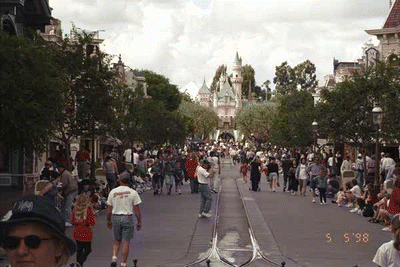
The next wienie is from Big Thunder Mountain Railroad. There is a story,
perhaps apocryphal, that as this spire was being constructed, an executive
looked out of his office window and decided that this wienie looked too
phallic, at least from his vantage point, and that top was removed and
reshaped.
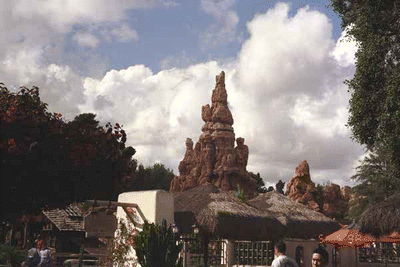
If you're having trouble designing a wienie, then you can always fall back
on creating a large pointy thing. The triangle below is part of the new
Innovations attraction located where Carousel of Progress (and later America
Sings) used to be. It's a great example of a modern wienie at Disneyland.
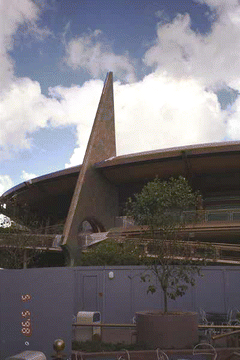
Below, you'll find another tall pointy wienie. The actual attraction is
below the fanciful antennae array pictured here. But this wienie serves the
purpose of drawing you into Tomorrowland.
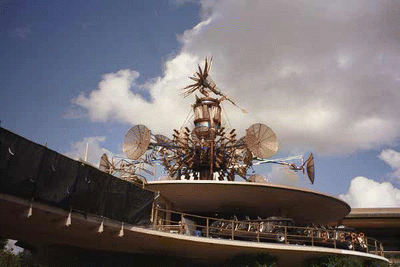
The Haunted Mansion
is another great wienie. For some reason this façade was built long before
the actual ride was created. (Very little of the ride - in fact, almost none
of it - is located in this façade. Most of it takes place a building hidden
behind the house itself behind the train tracks.) This wienie was very successful
in that everyone wanted to know what was inside! The buzz that was created by
this wienie long before the ride opened was huge! In modern times, as the
trees have grown up around the Mansion, it's not quite as striking as it used
to be. In fact, we'll see lots of former wienies have been hidden by trees as
the foliage in the park has matured. But it's worth noting that the Haunted
Mansion also has a somewhat tall
pointy thing on top of it.
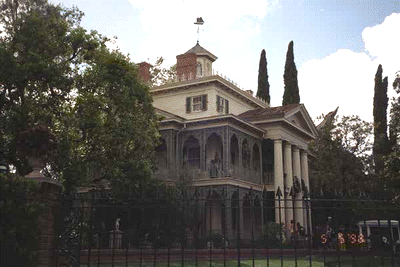
Audible Wienies
There is a new attraction in Tomorrowland called
the Rocket Rods that replace the old People Mover (or People Remover, as
insiders called it, since a couple of people died on it). The cool thing
about the Rocket Rods is a carefully pitched high-tech motor sound that the
cars make as they accelerate around the track. This draws your attention
right to the cars as the whiz by overhead.
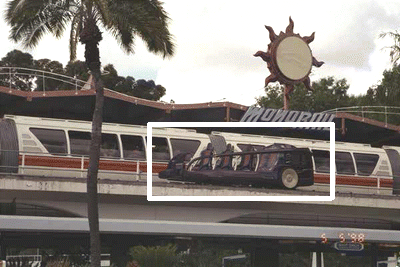
Splash Mountain
has a great audible wienie. The big splash from the vehicles
(which is faked) as they crash down the final drop also makes a big
sound. The sound is audible long before the splash becomes visible as you
make your way toward Critter Country.
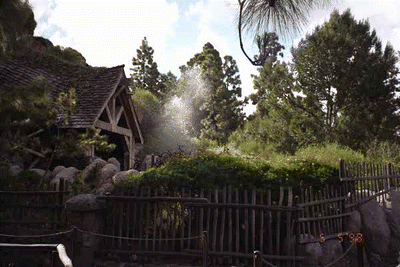
Non-Wienies
For unknown reasons, the art of wienie design was little used for
attractions developed in the eighties and nineties. For instance, the sign I
have outlined below is the only indication that this is where you enter Space
Mountain. The old entrance at
least was front-and-center with Space
Mountain itself and had an
appealing escalator to get you upstairs. Interestingly, this new entrance
replaces a restaurant that was hidden in the dark area behind the sign. The
restaurant was so invisible to park guests that it was only open on severely
busy days, when crowds of people were desperate to find food. Otherwise, no
one ever visited the restaurant at all.
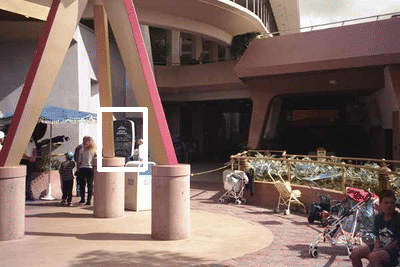
Pirates of the Caribbean, one of the most popular attractions ever at Disneyland, was wienieless. Before the ivy-covered bridge you see below
was constructed to help with crowd control during Fantasmic
showings (which severely clogged the pathways in New
Orleans Square near the Rivers of America), the
only evidence of Pirates was the little sign I have outlined near the center
of the picture. That sign is still present, but is not fairly well obscured
by this new bridge. Once you are on the bridge, it is not immediately obvious
how you get off the bridge and into the Pirates attraction. If you happen to
be on the correct level, and you happen to notice the two dark tunnels or the
small sign I outlined in the lower part of the picture, then you have a
chance of getting yourself onto the ride.
To be fair, in the old days of the late sixties and seventies, this ride
was so crowded, that all you had to do was look for a big line and you knew
you were near something cool. Also to be fair, Fantasmic
is so fantasically popular that something had to be
done to get people in and out of the area. (BTW, I think Fantasmic
is a combination of two words - the first is fantastic - and the second is
... Orgasmic? Just a guess.)
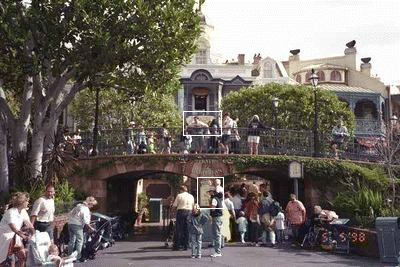
Enticements
All of the wienies so far have pointed directly to the place the Disneyland
planners want you to go. Sometimes it is nice to have something in the far
distance that attracts you forward, even though it is clear you're not going
to get their for some time. Below, this lovely bend in the Rivers of America
(which, of course, is not a river at all), draws you toward New
Orleans Square and around toward the Haunted
Mansion and Critter Country, even
though those areas are now completely obstructed by trees. The same thing
occurs going the other way - you're drawn around the river bend toward Big
Thunder Mountain
and the various paths that lead around it to Fantasyland and Main
Street.
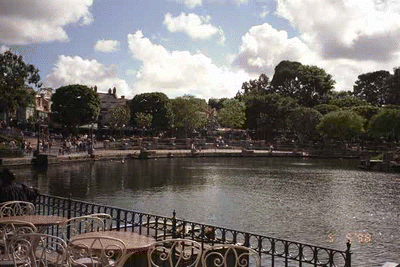
Here's another wienie that is a tall pointy thing - the cone and spires of
Space Mountain.
(Isn't that a great name? Space Mountain
- an oxymoron.) The trouble is you can't get there from here - this picture
was taken in Town Square of Main Street. If you try to go directly there and
through that tiny little door, you'll end up in the back stage area. The
problem that had to be solved here was to allow this thing to be visible,
just so you would know that there's other cool stuff awaiting you, but to not
make the path to it enticing enough to actually follow. So the door to the
backstage area is particularly bland. In this case, the small door is really
an anti-wienie, because it is supposed to suggest to you that you stay
away.
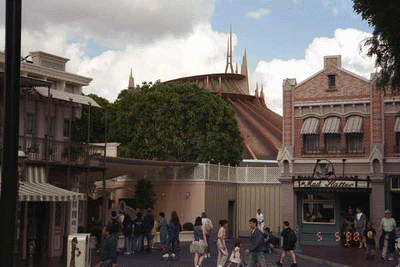
Hiding the edges
Speaking of anti-wienies, hiding the edges of your virtual world is
particularly difficult. Many of the levels in Unreal Tournament and Quake III
Arena are either enclosed in a exitless
building, or floating in space, where the punishment for falling off the edge
is severe. The Seventh Guest took placed (on purpose) in a closed
environment; and Myst took place on a series of
islands. The Legend of Zelda: The Ocarina of Time has a large open field in
the center of the game. I suspect hiding the edges of that area was a bit
difficult to design without looking too contrived. At Disneyland,
the edges of the park have the twin goal of keeping you inside without you
even getting the idea of trying to get out, and also hiding the outside world
of freeways and traffic. As in Zelda's open field, Disneyland's
guest areas are surrounded by all kinds of barriers. Some of the Disneyland
barriers do such a good job of separating you from the outside world that you
don't even notice that you've bumped up against an edge of the park. This is
done by making the barriers reach toward the sky, drawing your attention
upward and away from whatever might be behind the barriers.
The façade for It's a Small World is particularly engaging and so filled
with detail that its entertaining just to look at
it. (Much more entertaining than the ride inside, I think most adults would
agree.) Also, note once again the use of spires and other tall pointy things
to draw your attention upward to the open feeling of the sky (even with
clouds as in my pictures) which helps alleviate that closed-in feeling.
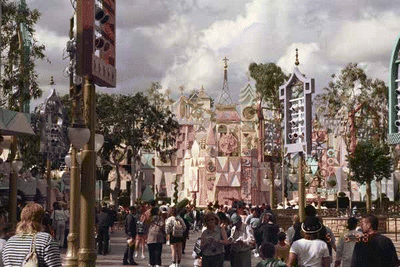
In Mickey's Toontown, the fake hills in the
distance suggest that Toontown continues forever.
But when you get up close to the buildings you lose sight of the mountain
ranges, and hopefully forget you're up against the outer edge of the park.
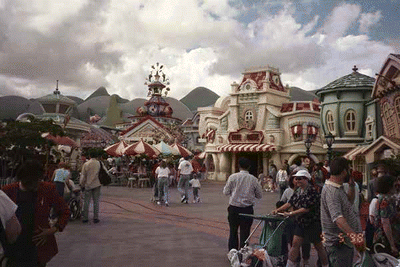
This last example of edge hiding is particularly effective. There's tons
of stuff to look at which entices you to find ways to explore it (but the
only way back there is on rides like the Monorail, Rocket Rods, Autopia, or Submarines); it gives you a huge sense of
depth; but you can't get there and probably don't really notice you are up
against one of the edges of the park.
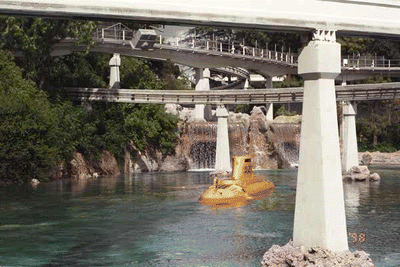
The Hub
Our final example is "The Hub" located at the center of Disneyland.
The Hub illustrates just about every principle, and error, in wienie design
possible. The pictures below are laid out to suggest a 180 degree view
(that's pi radians for you programmers) from the center of Disneyland
after you've made your way up Main Street
toward the castle. The center picture is in fact the view of the castle as
you get close. Just to make things more interesting, you can see King
Arthur's Carrousel through the portcullis of the castle. You might also hear
the Carrousel music as you approach which further draws you in.
However, the tall pointy thing called Matterhorn Mountain
is a stronger wienie and attracts the vast majority of guests. Probably 70%
of the first time visitors are drawn to the Matterhorn
which begins them on a counter-clockwise exploration of Disneyland.
A few will want to head to the right to the new Astro
Orbiter. This was just completing construction during my visit, and I must
confess to being worried that wienie is too close to the entrance to Tomorrowland and is likely to clog it with long lines in
the summer. Still, off in the distance you can see the tall pointy triangle
wienie of Innovations.
 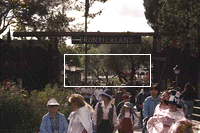
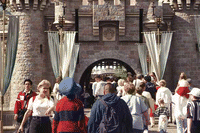
 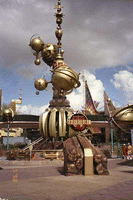
As you work your view around to the left (the first two pictures), you'll
see just want can go wrong with wienie design. The first picture is the view
of Adventureland from the Hub. The white arrow
points to some bathrooms. Within that last ten years or so, the bathrooms
were covered up by some clever design work. The Adventureland
bathrooms were always a humorous anti-wienie that new employees were taught
about during orientation. Adventureland is so
unattractive that most of the shops don't open until an hour or two after the
rest of the park. No one is going over there until they are forced to by the
crowds in front of the other wienies.
For Frontierland, the idea was that you would
sight down through the opening in the fort and see the Mark Twain Steamboat.
This was a good idea, but as the trees grew in, the view of the Steamboat got
completely obscured! Below, you can see the Steamboat (complete with tall
pointy things - the smokestacks) as it was visible in days of yore.
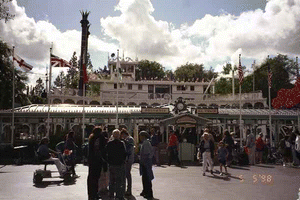
Summary
I've attempted here to introduce the term "wienie" to the game
community through examples and counter-examples from what I believe to be the
most successful 3D virtual environment ever - Disneyland. Ten million plus
visitors go to Disneyland every year for $35.00 a pop.
While inside, they explore, interact with NPCs (aka employees), buy stuff, buy food, sometimes store
their inventory in lockers, and generally wander around in exactly the ways
that the Disney designers want them to, without being told to do anything. On
the surface, it is a completely free environment to explore. But in fact, it
is a carefully manipulated and constrained experience. And it is my thesis
that the use of wienies in the design and layout of Disneyland
is a key factor in the enjoyment that guests derive from the park, and that a
similar approach will work for our own interactive worlds. (And don't forget
- when you're stuck for an idea for a wienie, try a tall pointy thing.)
BIO
Stephen Clarke-Willson earned a Ph.D. in Software Engineering from the University
of California, Irvine,
in 1986. Since 1990 he has been involved in the production, design, and
programming of video and computer games and other virtual worlds. He has
visited Disneyland over 200 times as a guest in
addition to working as a Disneyland employee on Davy
Crockett's Explorer Canoes. He can be reached at s t e p h e n @ a b o v e –
t h e – g a r a g e . c o m
.
|



















